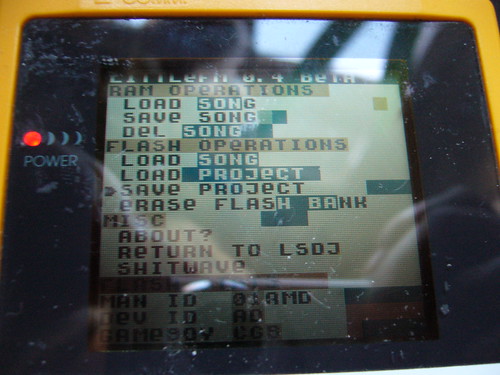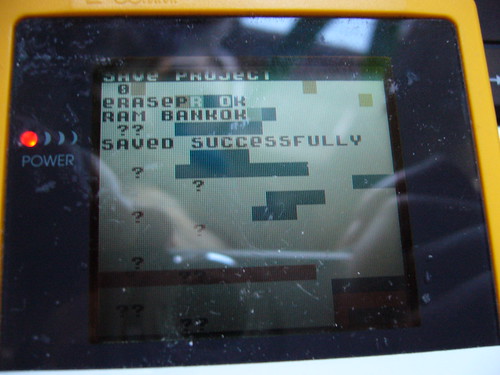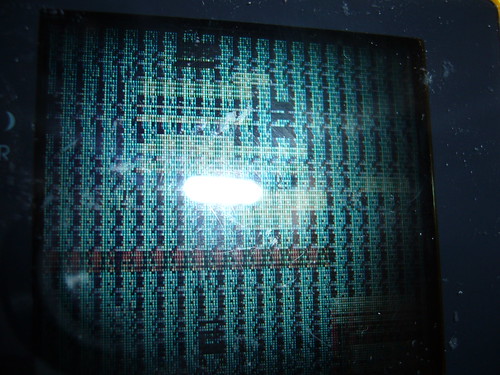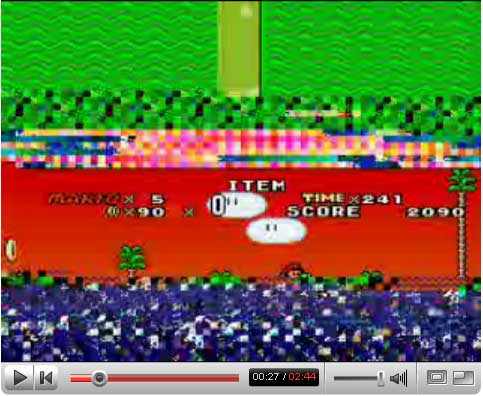LittleFM on GBC
February 7th, 2010I finally felt motivated to work a little on LittleFM, and the next feature in the pipeline was (the comparitively small) feature of “real” GBC support, ie support for double speed and colour palettes in LSDj which LittleFM has been lacking so far. (Instead it used the oldschool compatibility mode which didn’t allow LSDj to take advantage of the higher CPU speed found in the GBC)
It works great and flashing takes about half the time when done in double speed mode, however I forgot to clear the secondary GBC bakground map when going from LSDj back into LFM, using the classic sel-start-B-A combo. What this means is that the colour pattern from LSDj will not be erased but remain on the screen. This gave this nice visual bug seen below. As you can see, the pattern resembles LSDj’s screen layout.


I’m going to finish one more feature before I release LittleFM 0.4, loading and saving of individual LSDj files, so LFM can truly replace the builtin file manager that comes with LSDj. I have an almost working version of this feature, but it has wrinkles which I want to iron out before releasing it.
The last picture is shitwave which actually looks marvellous with the backgrounds residue. It gives the vibrations more life and you can see what’s actually happenening rather than just vaguely vibrating lines. It may not be apparent on the still image, but it looks nice live.

Sorry for the long wait, but have patience!
Freaky military robot
March 21st, 2008
This beast is called the BigDog quadruped robot, and is a walking robot meant for military purposes.
Now, the incredible thing isn’t that it is a walking robot, walking robots have existed at least for a decade. The incredible thing is the extreme precision at which it handles balance. That is what makes it seem so alive.
But I admit, it feels kind of freaky with that noise (Which sounds like a cry) and the two “horns” (Which are probably accelerometers)
Laser Graffiti
January 30th, 2008This is some cool shit that Graffiti Research Lab Vienna presented 24C3. As far as I understand, this is how to do it: You’re using a projector and a digital video camera, forming a closed loop system, where data is fed back into system. You project an image to a wall that you also film with the camera. After calibration you can point a laser point to the wall. The camera sees this point of light and draws light on the area of projection.
Links:
Graffiti Research Lab Vienna
Article on makeblog (Instruction video)
Article on muonics.net (Detailed instructions)
Report from rsms@copyriot, who was there (In Swedish)
Subliminal marketing
January 28th, 2008
Ever heard of subliminal split frame marketing? Guess what, I just fell for it in an SMW hack video on YouTube. (Although you could just argue it was a glitch.)
This hack is the awesome kind where the creator actually put some effort into his (or her) hack. Download it from here: http://www.smwcentral.net/?p=showhack&id=363
Destroy your boot sector!
November 13th, 2007What do I and Dustin over at Virtual Roadside have in common? Let’s see, we’re geeky, we follow xkcd, and we luuuv messing around with boot sectors!
He made a nice snippet of ASM that resides in your MBR, which prints a little message of your choice. It’s inspired by this XKCD strip:

This takes me right back to when I was twelve or so and got Form.B from a floppy. I actually noticed it myself, and I checked it out with a program that could read flopppy disks on a low level. I don’t remember why I had such a program lying around, but I think it had something to do with my interest in DMF formatting, which allowed you to store 1.72 MB of data on a 1.44 MB floppy by (mis)using otherwise unused space. Anyway, the Form.B virus had a nice little message in it, greeting whoever managed to read it. I never felt that close to hardware until I started programming the Gameboy.
Where was I… Oh yeah, the MBR love letter. I tried it, and also filmed it and put on youtube, which you can watch below. I have the FreeBSD boot loader installed, which booted just fine. Maybe a computer with the MBR love letter is actually supposed to just boot afterwards, when using Windows’ boot loader, just that Dustin don’t want to say that out loud, so that less people will try it on their on computers? (No I haven’t checked the source code myself. It’s 6 AM and I’ve been up all night. Hopefully I’ll go to bed when I’ve finish this post.)
Now that the demo scene is producing size demos (Everything from 32 bytes up to 512 bytes) you could probably fit one of these into the boot sector to make this hack even nicer.
If you can’t read that blurry poem, it says:
Love me, love me not My 'puter is all I got With this malicious vector Can I really restore my boot sector?
On a related note, recently the computer virus had its 25th anniversary. I’ve meant to say something about this, but I never got about doing it.
Edit:As Dustin points out the FBSD boot loader is only one boot sector big, which would be the reason why it works. Not only that, just by pressing any of the F keys associated with a partition, the boot loader automatically rewrites itself into the MBR. (The reason for this is to save the selection as the new default to the next next boot.)
New anti-spam technique implemented
July 8th, 2007I hate spam, and if you’ve been following this blog you might’ve noticed that it has been 100% spam free. This is because I’ve set WordPress to require confirmation from me before posting anything. However, after a while I totally drowned in spam. So I made a dictionary of common words used in the spam I got, and hard blocked these comments. It worked fine for a while, and I kept adding phrases to the dictionary. But then after a while it got out of hand.
So now I’m using a second anti-spam technique based on Javascript. I’m actually so confident it will work well that I have turned off the word filtering and e-mail confirmation for now. (Posts with more than two links in them still require confirmation by me though) If any spam gets through I’ll re-activate one or both of the other methods in conjunction with the new one.
The system works by running a very obfuscated piece of javascript that creates new form elements and also renames (Changes the name property) of existing ones.
The downside with the current system is that users browsing the web with Javscript turned off won’t be able to leave comments, but in the end I think it’s a good tradeoff.
![You suck at protoshop. No, you [i]really[/i] oo.](http://blog.gg8.se/images/you-suck-at-photoshop-you-really-do-your-awful.png)


